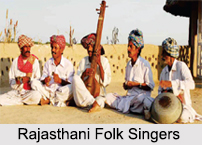 Rajasthani Folk songs are defined as the natural expression of human emotion and they basically pertain to religious and other aspects of day to day life. Songs associating with rituals and worship are religious and they are distinct from the ones pertaining to particular occasions and events. Several folk songs have been so far published in different times by different scholars. `Sabad`, `Bhajan`, `Harjas` are some of the popular Rajasthani folk songs, which bear the culture and tradition of Rajasthan.
Rajasthani Folk songs are defined as the natural expression of human emotion and they basically pertain to religious and other aspects of day to day life. Songs associating with rituals and worship are religious and they are distinct from the ones pertaining to particular occasions and events. Several folk songs have been so far published in different times by different scholars. `Sabad`, `Bhajan`, `Harjas` are some of the popular Rajasthani folk songs, which bear the culture and tradition of Rajasthan.
Class of Rajasthani Folk Songs
The classes of Rajasthani folk songs are Banada (Bridegroom), Janwai (son-in-law), Olyun (memory), Jalal (songs based on the love story of Jalal-Bubaba), Daph (tambourine, songs sung to its accompaniment during Holi festival also known as Dhamal), Badhawa (songs sung on festive and other auspicious occasions), Ghodi (songs sung at the time when the bridegroom rides a mare), Gangaur (songs of a festival), Bhat (songs on a ceremony connected with marriage), Ratijago (songs sung during the night in marriage ceremonies) and lastly, Tij (songs sung at the time of a popular festival during the monsoon). Some of them bear the features of Indian classical music. Many padas popular in the name of Mira Bai are composed on the pattern of Banada and Janwai class of folk songs.
Features of Rajasthani Folk Songs
There are several types of Rajasthani folk songs which bear their own features exhibiting the culture of Rajasthan. Some of the Rajasthani folk songs are written with the names of Gods like Ramdevji, Gogoji, Pabuji, Mehaji and Harbuji. They are the deities of Rajasthan, who are called "Panch Pir" together. Some other types of folk songs bear the names of their composers and they are known as "padas". The "padas" are believed to be the creation of Ramdevji. There are two types of "padas"- Caubis Praman and Songs or Sabads. Both are stray padas on devotional topics containing the precepts of Ramdevji. In the Caubis Praman, the views of Ramdevji on twenty four topics are given. The songs are on Nirgun bhakti, exaltation of Gods, freedom from idolatry, emphasis on self realisation, preaching as well as warnings. All such feelings have been expressed with complete ease and intensity in popular Rajasthani language.
Classical Rajasthani Folk Songs
Many of the Rajasthani folk songs are classical. Olyun, Pinpali, Gangaur, Ghugari, Mumal, etc. are some of the examples of classical folk songs. They are mostly popular for their tunes. Some Rajasthani folk songs of classical base anticipate the stories of Bidai- relating to daughter`s departure from the parental home after marriage and relationship between brother and sister- Haras and Jin are the types of songs.




